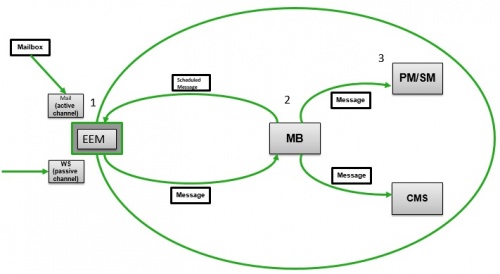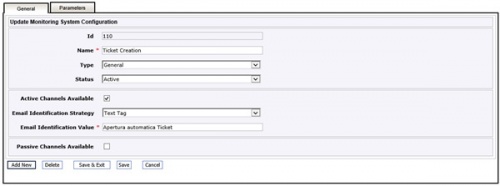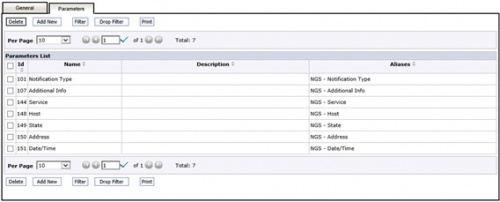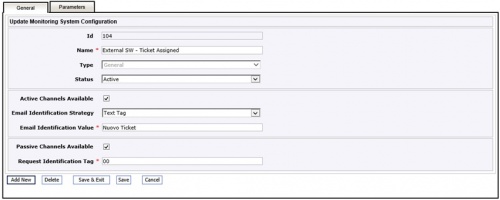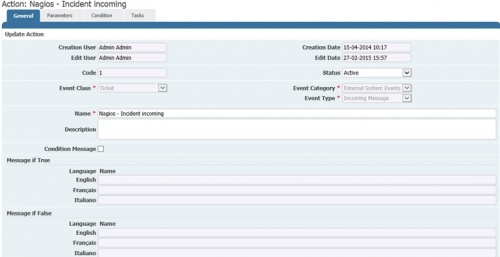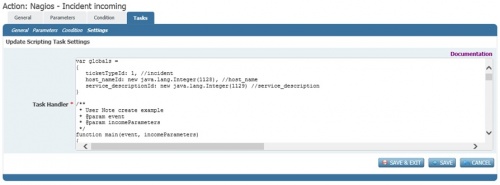Differenze tra le versioni di "EEM - External Event Management"
(→Active channel) (Etichetta: visualeditor) |
(→Active channel configuration) (Etichetta: visualeditor) |
||
| Riga 29: | Riga 29: | ||
The steps to properly configure ''[[Glossary|active channels]]'' are: | The steps to properly configure ''[[Glossary|active channels]]'' are: | ||
* Define one or more ''[[Glossary|active channel]]'' | * Define one or more ''[[Glossary|active channel]]'' | ||
| − | * Configure a | + | * Configure a ''[[Glossary|monitoring system configuration]]'' ([[Glossary|MSC]]) for validation |
| − | Using EEM | + | ===== Definition of active channels ===== |
| + | Using ''[[Glossary|EEM]]'' menu '''''Active Notification Channels''''' it is possible to define an ''[[Glossary|active channe]]''l which is mapped on an existing mailbox. | ||
| − | The image below shown the | + | The image below shown the parameters needed to configure an ''[[Glossary|active channel]]''. |
[[File:EEM active channel configuration schema v1.0.jpg|centre|thumb|500x500px|EEM Active channel]] | [[File:EEM active channel configuration schema v1.0.jpg|centre|thumb|500x500px|EEM Active channel]] | ||
| + | The following parameters shall be provided: | ||
| + | |||
| + | ===== Definition of monitoring system configurations ===== | ||
An MSC (Monitoring System Configuration) is composed by General and Parameter informations. | An MSC (Monitoring System Configuration) is composed by General and Parameter informations. | ||
Versione delle 07:56, 18 ago 2015
EEM - External Event Management is one of the complementary modules of itmSUITE®. The module is aimed to enable interactions between itmSUITE® and third party applications (interfaces). The supported direction of the data flow is from the external application to itmSUITE® (input). It is possible to define and implement outbound data flow and interfaces by using the action engine component of the itmSUITE®.
Indice
Introduction
The module can receive information (inbound messages) with two modes which may be activated at the same time:
Active channel
In this mode data acquisition is made by means of mails. EEM verifies at regular intervals the existence of mail messages in a configured mailbox and processes them when found.
Passive channel
In this mode, EEM makes available web services in order to acquire data.
EEM processing steps
EEM works on inbound messages received by means of the active or passive channel through a three steps process:
- EEM processes and validates the incoming message
- EEM passes processed messages to message bus which, in turn, dispatches them to the recipients (the modules configured to subscribe to the message)
- itmSUITE® recipient module performs the configured tasks for the received message by means of the action engine
The above mentioned three steps process is illustrated in the figure below.
EEM configuration
The following paragraphs gives an overview of EEM configuration.
Active channel configuration
The steps to properly configure active channels are:
- Define one or more active channel
- Configure a monitoring system configuration (MSC) for validation
Definition of active channels
Using EEM menu Active Notification Channels it is possible to define an active channel which is mapped on an existing mailbox.
The image below shown the parameters needed to configure an active channel.
The following parameters shall be provided:
Definition of monitoring system configurations
An MSC (Monitoring System Configuration) is composed by General and Parameter informations.
The image below shown the General tab used by the system to validate the incoming data
The image below shown the Parameter tab used by the system to collect information present on a message.
One message is validated if the Identification Strategy is respected and all the parameters are presents into the body of message
Passive channel
When itmSUITE® is called from third parites system is necessary to define the validation rule using the MSC (monitoring sytem configuration) session.
In this case, a client call is accepted if the Request Identification tag and the expected Parameters are properly passed into the SOAP message.
The image below shown a MSC (monitoring sytem configuration) configuration session.
Action Engine Configuration
When the incoming message is validated by EEM, the informations are sent to MB (Message Bus) that dispatch it to the itmSUITE® Action engine and a configured Action is activated.
Action Engine enabled the user to configured an Action and the activation condition. An action is composed by:
- General Information
- Trigger and Activation condition
- Parameters
- Tasks to execute
the following images shown the action' user interface and provide some more detail about this functionality
Condition'tab enable the user to define a Boolean condition that should be verify before activate the action' . Generally the conditions works on input Parameter.
Tasks tab enable the user to define one or more task that will be executed sequentially if the condition is valid. The system manage different type of task, the most flexible and powerful is Scripting task, based on Javascript framework, enable the user to call itmSUITE® primitive
Outbound Comunication
itmSUITE® module can send information towards third parties software using scripting tasks. This can be performed:
- Sending a preformatted mail
- Calling a third parties web services
